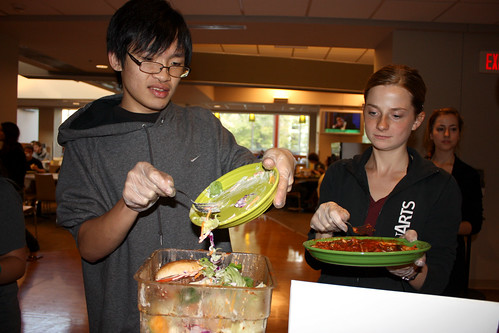
Dining Services has launched a new campaign, WasteNot, to encourage students to think twice about portion size and food waste.
Nine-hundred-fifty-three pounds. Nine-hundred-fifty-three pounds of half-eaten cheesy pizza slices, chocolate chip cookies with one bite taken out of them, slightly nibbled pieces of chicken, nearly full plates of pasta and meaty hamburgers with a chunk missing, all mushed together and sitting at the bottom of a trash can. This is the scene that students were responsible for last Tuesday in the Johnson & Hardwick cafeteria.
As part of Temple Dining Services WasteNot campaign, students were asked to pour all of their food waste onto a scale to be weighed before taking their trays to be washed. At the end of the day, Dining Services added all of the numbers up and discovered that just on that one day at J&H, Temple students threw away 953 pounds of food. According to Dining Services, 615 additional meals could have been served from that waste.
“I am disgusted by it,” said Chelsey Lowe, a sophomore political science and geography and urban studies major and one of the student volunteers weighing trash at the event. “I just watched someone throw out an entire plate of pasta and they didn’t even take one bite out of it.”
Part of the food waste problem is fed by what dining services calls “portion distortion.” Food portions in the U.S. have more than doubled in the past 25 years and as a result, students do not shy away from fitting the maximum number of plates possible onto their trays.
Then one of two things can happen: students either can’t finish that much food so they throw it away, or they can finish that much food, and they throw it all away into their stomachs. Both options in this scenario are harmful.
The recommended daily caloric intake for young and active people is approximately 1,200 calories for women and approximately 1,800 for men. At the same time, a restaurant-sized portion of pasta can contain 1,000 calories or more, and that is not including breadsticks, drinks and dessert. That is already half of the calories that should be consumed in one day, all taken in at one meal.
To combat this, J&H held a portion distortion and tapas dinner night, on Thursday Sept. 22, to show students what portions are supposed to look like. Tapas are small Spanish-style snacks and appetizers that show bigger is not always better.
“We used tapas and small plates of food to show that you can go out to eat and still be healthy,” said Julie Ruhl, the registered dietician at J&H. “A proper portion of protein is only three ounces. We give out that amount but many people take multiple plates. It’s all about personal responsibility.”
Overeating and wasting in the cafeteria can lead to more than just expanding waste lines and piles of rotting trash, they can have environmental impacts as well. Not only is energy wasted cooking food that no one ends up eating, but that waste often ends up in landfills where it emits methane, a greenhouse gas.
The food waste from the J&H is sent away and composted to be used as fertilizer, rather than just rotting in a landfill.
Through a series of portion control campaigns, J&H aims to cut its daily waste in half by Earth Day on April 22, 2012, but this can only happen through student awareness and action.
“Students take the cafeteria for granted,” Kyle Goldstein, a senior civil engineering major, said. “It doesn’t cost extra to take more food, so it is easy to take advantage.”
Dining Services hopes by informing students about the effects of their eating habits, a real change will be seen in the amount of waste produced.
Reducing food waste can be a relatively easy task, but it starts with awareness, and that is what Dining Services is trying to achieve.
Amy Stansbury can be reached at amy.stansbury@temple.edu



Be the first to comment